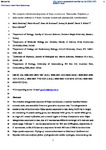The complete mitochondrial genome of Talpa martinorum (Mammalia: Talpidae), a mole species endemic to Thrace: genome content and phylogenetic considerations
| dc.contributor.author | Demirtas, S | |
| dc.contributor.author | Budak, M | |
| dc.contributor.author | Korkmaz, EM | |
| dc.contributor.author | Searle, JB | |
| dc.contributor.author | Bilton, David | |
| dc.contributor.author | Gunduz, I | |
| dc.date.accessioned | 2022-08-18T11:52:45Z | |
| dc.date.issued | 2022-08-27 | |
| dc.identifier.issn | 1573-6857 | |
| dc.identifier.issn | 1573-6857 | |
| dc.identifier.uri | http://hdl.handle.net/10026.1/19548 | |
| dc.description.abstract |
The complete mitogenome sequence of Talpa martinorum, a recently described Balkan endemic mole, was assembled from next generation sequence data. The mitogenome is similar to that of the three other Talpa species sequenced to date, being 16,835 bp in length, and containing 13 protein-coding genes, two ribosomal RNA genes, 22 transfer RNA genes, an origin of L-strand replication, and a control region or D-loop. Compared to other Talpa mitogenomes sequenced to date, that of T. martinorum differs in the length of D-loop and stop codon usage. TAG and T-- are the stop codons for the ND1 and ATP8 genes, respectively, in T. martinorum, whilst TAA acts as a stop codon for both ND1 and ATP8 in the other three Talpa species sequenced. Phylogeny reconstructions based on Maximum Likelihood and Bayesian inference analyses yielded phylogenies with similar topologies, demonstrating that T. martinorum nests within the western lineage of the genus, being closely related to T. aquitania and T. occidentalis. | |
| dc.format.extent | 317-325 | |
| dc.format.medium | Print-Electronic | |
| dc.language | en | |
| dc.language.iso | en | |
| dc.publisher | Springer | |
| dc.subject | Talpa martinorum | |
| dc.subject | Mitogenome | |
| dc.subject | Phylogenetic | |
| dc.title | The complete mitochondrial genome of Talpa martinorum (Mammalia: Talpidae), a mole species endemic to Thrace: genome content and phylogenetic considerations | |
| dc.type | journal-article | |
| dc.type | Journal Article | |
| plymouth.author-url | https://www.webofscience.com/api/gateway?GWVersion=2&SrcApp=PARTNER_APP&SrcAuth=LinksAMR&KeyUT=WOS:000847048400001&DestLinkType=FullRecord&DestApp=ALL_WOS&UsrCustomerID=11bb513d99f797142bcfeffcc58ea008 | |
| plymouth.issue | 5 | |
| plymouth.volume | 150 | |
| plymouth.publication-status | Published | |
| plymouth.journal | Genetica | |
| dc.identifier.doi | 10.1007/s10709-022-00162-w | |
| plymouth.organisational-group | /Plymouth | |
| plymouth.organisational-group | /Plymouth/Faculty of Science and Engineering | |
| plymouth.organisational-group | /Plymouth/Faculty of Science and Engineering/School of Biological and Marine Sciences | |
| plymouth.organisational-group | /Plymouth/REF 2021 Researchers by UoA | |
| plymouth.organisational-group | /Plymouth/REF 2021 Researchers by UoA/UoA07 Earth Systems and Environmental Sciences | |
| plymouth.organisational-group | /Plymouth/Research Groups | |
| plymouth.organisational-group | /Plymouth/Research Groups/Marine Institute | |
| plymouth.organisational-group | /Plymouth/Users by role | |
| plymouth.organisational-group | /Plymouth/Users by role/Academics | |
| dc.publisher.place | Netherlands | |
| dcterms.dateAccepted | 2022-08-04 | |
| dc.rights.embargodate | 2023-8-27 | |
| dc.identifier.eissn | 1573-6857 | |
| dc.rights.embargoperiod | Not known | |
| rioxxterms.versionofrecord | 10.1007/s10709-022-00162-w | |
| rioxxterms.licenseref.uri | http://www.rioxx.net/licenses/all-rights-reserved | |
| rioxxterms.type | Journal Article/Review |


